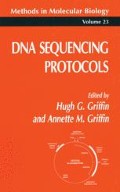Abstract
Efficient completion of large DNA sequencing projects has been greatly facilitated by the development of fluorescence-based dideoxynucleotide sequencing chemistries and instruments for real-time detection of fluorescence-labeled DNA fragments during gel electrophoresis (1–6;see Chapter 1). Besides eliminating the use of radioisotopes, these systems automate the task of reading sequences and provide computerreadable data that may be directly analyzed or entered into a sequence assembly engine. In this chapter, we describe DNA sequencing using the first commercially-available fluorescent instrument, the Applied Biosystems, Inc. Model 373A Automated DNA Sequencer. This sequencer, originally introduced in 1987 as the Model 370A, utilizes a multi-spectral approach in which four distinct fluorescent tags are detected and differentiated in a single lane on the sequencing gel (6). The four tags are incorporated during the DNA sequencing reactions and may be present on either the 5′ end of the sequencing primer (”dye-primers”) or on the dideoxynucleotide triphosphate (”dye-terminators”). Since the 373A requires only one lane per sample, up to thirty-six samples may be analyzed per run. By comparison, the DuPont Genesis system currently supports only a four-dye, one-lane dye-terminator chemistry and allows analysis of up to twelve samples per run. The Pharmacia ALF sequencer supports only a one-dye, fourlane approach with dye-labeled primer, and can analyze up to ten samples per run. The ability of the 373A to use both dye-primer and dyeterminator chemistries greatly facilitates the completion of projects that require both shotgun and primer-directed sequencing phases
Access this chapter
Tax calculation will be finalised at checkout
Purchases are for personal use only
References
Smith, L. M., Sanders, J. Z., Kaiser, R J, Hughes, P, Dodd, C., Connell, C R., Heiner, C., Kent, S. B. H., and Hood, L. E. (1986) Fluorescence detection in automated DNA sequencmg. Nature 321, 674–679.
Ansorge, W., Sproat, B. S., Stegemann, J., Schwager, C., and Zenke, M. (1987) Automated DNA sequencmg: Ultrasensitive detection of fluorescent bands during electrophoresis. Nucl. Acids Res. 15, 4593–4602.
Prober, J M., Trainor, G L., Dam, R. J., Hobbs, F. W., Robertson, C. W, Zagursky, R. J., Cocuzza, A J, Jensen, M. A., and Baumeister, K. (1987) A system for rapid DNA sequencing with fluorescent chain-terminating dideoxynucleotides. Science 238, 336–341.
Brumbaugh, J. A., Middendorf, L R, Grone, D. L., and Ruth, J L. (1988) Continuous, on-line DNA sequencing using ohgodeoxynucleotide primer wrth multiple fluorophores. Proc. Nutf Acad. Sci. USA 85, 5610–5614
Kambara, H., Nrshikawa, T., Katayama, Y., and Yamaguchi, T. (1988) Optimization of parameters m a DNA sequenator using fluorescence detectron. Biotechnology 6, 816–821.
Connell, C. R., Fung, S., Heiner, C, Bridgham, J, Chakerian, V, Heron, E, Jones, B., Menchen, S, Mordan, W., Raff, M, Recknor, M., Smith, L, Springer, J, Woo, S., and Hunkapiller, M. (1987) Automated DNA sequence analysis BioTechniques 6, 342–348
Tabor, S. and Richardson, C. C. (1987) DNA sequence analysis with a modified bacteriophage T7 DNA polymerase. Proc. Natl. Acad. SCL USA 84, 4767–4771.
Tabor, S. and Richardson, C C (1989) Effect of manganese tons on the mcorporation of dideoxynucleotides by bacteriophage T7 DNA polymerase. Proc. Nat1 Acad Sci USA 86, 4076–4080
Wilson, R. K., Chen, C., and Hood, L. (1990) Opttmization of asymmetrrc polymerase chain reaction for fluorescent DNA sequencing. BloTechniques 8, 184–189.
Wilson, R K, Chen, C, Avdalovic, N., Burns, J, and Hood, L. (1990) Development of an automated procedure for fluorescent DNA sequencing. Genomics 6, 626–634.
Koop, B F., Wilson, R, K., Chen, C., Halloran, N., Sciammis, R., and Hood, L. (1990) Sequencing reactions in microtiter plates. BioTechniques 9, 32–37.
Seto, D. (1991) A temperature regulator for microtiter plates. Nucl Acids Res 19, 2506.
Author information
Authors and Affiliations
Editor information
Editors and Affiliations
Rights and permissions
Copyright information
© 1993 Humana Press Inc. Totowa, New Jersey
About this protocol
Cite this protocol
Halloran, N., Du, Z., Wilson, R.K. (1993). Sequencing Reactions for the Applied Biosystems 373AAutomated DNA Sequencer. In: Griffin, H.G., Griffin, A.M. (eds) DNA Sequencing Protocols. Methods in Molecular Biology™, vol 23. Humana Press. https://doi.org/10.1385/0-89603-248-5:297
Download citation
DOI: https://doi.org/10.1385/0-89603-248-5:297
Publisher Name: Humana Press
Print ISBN: 978-0-89603-248-4
Online ISBN: 978-1-59259-510-5
eBook Packages: Springer Protocols

